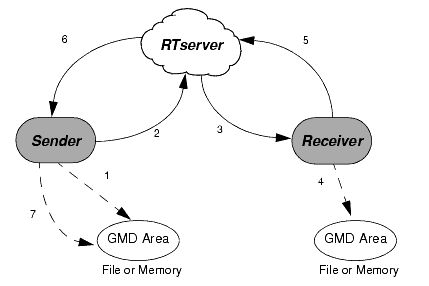
TIBCO SmartSockets includes the capability to guarantee message delivery. This ensures reliability even in the face of network or system failures and eliminates the need to write complex error recovery code. Figure 11 illustrates the successful processing of a guaranteed message.

If the sender does not get an acknowledgment within a specified time period, the message can be resent.
It is very simple to change the sending program used at the beginning of this lesson to make use of guaranteed message delivery.
Edit the send.c program
Edit send.c to add this line of code before the while loop:
The call to TipcMtSetDeliveryMode sets the delivery mode message property on all messages of type MSG_COUNT. You can also specify the delivery mode on a per-message basis by using the function TipcMsgSetDeliveryMode. The delivery mode T_IPC_DELIVERY_ALL is used to guarantee that the message arrives at all receivers. Other delivery modes are described in Delivery Mode in Chapter 2, Messages, of the TIBCO SmartSockets User’s Guide.
Set the Server_Disconnect_Mode
Set the Server_Disconnect_Mode option of the receiving program you used earlier in this lesson. The easiest way to do this is to modify the receive.cm file that is read in by the program. Add this line to the end of this file:
These are the only changes needed to guarantee message delivery — you can use the default values for other options that affect GMD. For example, the default value for the Ipc_Gmd_Type option causes file-based GMD to be attempted, and if that is unsuccessful, TIBCO SmartSockets reverts to memory-based GMD.
For more information on all the options that affect GMD and using them to configure GMD, see the TIBCO SmartSockets User’s Guide.
Compile, link, and start the revised sending program
After you have made the change to send.c, rebuild the program.
Start the receiving program
Start the receiving program:
If RTserver was not previously running, it is started automatically.
Start the edited sending program
With RTserver and the receiving program running, start the sending program in a different window:
As in the earlier exercises, the sending and receiving programs print a line of output for each message processed. To test GMD, a network failure must be simulated.
Stop the receiving program
Go to the window running the receiving program and stop it by typing Ctrl-c. Wait a few seconds, and then restart it using the command shown above. Notice that when the receiving program came back up, it received all the messages that had been sent while it was down.
Stop the RTserver
Go to another window and stop the RTserver with this command:
As you saw earlier, RTserver restarts automatically when the sender tries to send a message. When RTserver comes back, the sender automatically resends any messages that have not arrived at the receiver. You are able to verify by the message counts in the receiver’s output that the receiver has received all messages.
Guaranteed messages can be given a time-to-live by setting their delivery timeout message property using the function TipcMsgSetDeliveryTimeout(msg, timeout). If a guaranteed message is not acknowledged within the amount of time specified by timeout, a GMD_FAILURE message is sent to the sender to notify it of this problem. See TipcMsgSetDeliveryTimeout in the TIBCO SmartSockets Application Programming Interface reference for more details.
If the delivery timeout message property is not explicitly set, the value defaults to the setting of the RTclient option Server_Delivery_Timeout. If this option is not set, the default value is 30 seconds.
Stop the receiving program
Go to the window running the receiving program and stop it by typing Ctrl-c. If the receiving program is down for an extended period of time, the sending program begins to print a message for each guaranteed message that was not acknowledged within the timeout interval:
WARNING: Guaranteed message delivery failed (error code T_ERR_GMD_SENDER_TIMEOUT) on the connection <client:local:_node:RTSERVER>. WARNING: The message was originally sent at 17:31:24. WARNING: Did not receive acknowledgment within 30 seconds for the following guaranteed message: type = msg_count sender = </lesson6/send> dest = </tutorial/lesson6> max = 8 size = 8 current = 0 read_only = true priority = 0 delivery_mode = all ref_count = 1 seq_num = 2091 resend_mode = false user_prop = 0 delivery_timeout = 30 data (num_fields = 1): int4 5
This is the default action taken when the message delivery timeout is exceeded. You can override this behavior by defining your own GMD_FAILURE callback. In this callback, you have the ability to:
For more details on GMD see the guaranteed message delivery section in the connections chapter of the TIBCO SmartSockets User’s Guide.
When a message is guaranteed, its status can be checked at any time using the TipcSrvGmdMsgStatus function. TipcSrvGmdMsgStatus polls for the current GMD status of a message by sending a GMD_STATUS_CALL request to RTserver. RTserver responds by sending back a GMD_STATUS_RESULT message that contains a list of RTclients that have successfully acknowledged the message, as well as a list where GMD failed. You can use functions such as TipcSrvMsgSearchType to get the response. TipcSrvGmdMsgStatus is usually only used from a GMD_FAILURE process callback, but it can be called at any time by advanced applications that wish to poll for GMD status.
When RTserver routes a message for GMD, it keeps track of which RTclients should receive the message and the status of GMD to each of these RTclients. The GMD_STATUS_RESULT message contains these four fields:
See TipcSrvGmdMsgStatus in the TIBCO SmartSockets Application Programming Interface reference for more information on checking on the status of message delivery.
|
TIBCO SmartSockets™ Tutorial Software Release 6.8, July 2006 Copyright © TIBCO Software Inc. All rights reserved www.tibco.com |